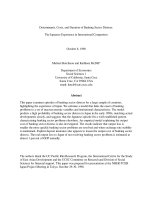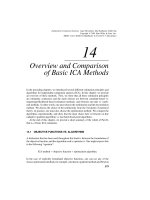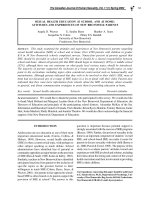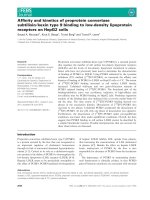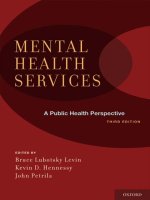Tài liệu SEXUAL HEALTH EDUCATION A T SCHOOL AND A T HOME: ATTITUDES AND EXPERIENCES OF NEW BRUNSWICK PARENTS pptx
Bạn đang xem bản rút gọn của tài liệu. Xem và tải ngay bản đầy đủ của tài liệu tại đây (417.53 KB, 13 trang )
19
The Canadian Journal of Human Sexuality, Vol. 11 (1) Spring 2002
INTRODUCTION
Adolescents rate sex education as one of their most
important educational needs (Cairns, Collins, &
Hiebert, 1994). However, sexual health education
(SHE) is often a controversial topic, with perhaps no
other subject sparking as much debate. School
administrators have identified fear of parental or
community opposition as major barriers to the provision
of SHE (Reis & Seidl, 1989; Scales & Kirby, 1983).
Similarly, teachers in New Brunswick have identified
anticipated reactions from parents to the inclusion of
specific topics as the greatest barrier to their
willingness to teach SHE (Cohen, Byers, Sears, &
Weaver, 2001). Are parents in fact opposed to school-
based SHE as often feared or do parents support the
provision of SHE at school? The answer to this
SEXUAL HEALTH EDUCATION AT SCHOOL AND AT HOME:
ATTITUDES AND EXPERIENCES OF NEW BRUNSWICK PARENTS
Angela D. Weaver E. Sandra Byers Heather A. Sears
Jacqueline N. Cohen Hilary E.S. Randall
University of New Brunswick
Fredericton, New Brunswick
question is important because parental support is
strongly associated with the success of SHE programs
(Rienzo, 1989). Further, discussion of sexuality in the
home is an important component of students’ overall
SHE, and school-based SHE can make it easier for
parents to discuss sexuality with their child (Berne et
al., 2000; Parcel & Coreil, 1985). The purpose of this
study was to evaluate parents’ attitudes toward and
experiences with SHE at school and at home, including
their ideas about the timing and content of the sexual
health curriculum and their involvement in providing
SHE to their children.
Correspondence concerning this paper should be addressed
to E. Sandra Byers, Ph.D., Department of Psychology, Uni-
versity of New Brunswick, Bag Service #45444, Fredericton,
New Brunswick E3B 6E4. E-mail:
ABSTRACT: This study examined the attitudes and experiences of New Brunswick parents regarding
sexual health education (SHE) at school and at home. Over 4200 parents with children in grades
K-8 in 30 New Brunswick schools completed surveys. Ninety-four percent of parents agreed that
SHE should be provided in school and 95% felt that it should be a shared responsibility between
school and home. Almost all parents felt that SHE should begin in elementary (65%) or middle school
(32%), although there was not consensus on what grade level various topics should be introduced.
The majority of parents supported the inclusion of a broad range of sexual health topics at some
point in the curriculum, including topics often considered controversial such as homosexuality and
masturbation. Although parents indicated that they wish to be involved in their child’s SHE, most of
them had not discussed any of a range of SHE topics in a lot of detail with their child. Parents also
indicated that they want more information from schools about the SHE curriculum, about sexuality
in general, and about communication strategies to assist them in providing education at home.
Key words: Sexual health education Schools Parents Parental attitudes
ACKNOWLEDGMENT: We would like to thank the parents who participated in this survey. We would also like
to thank Mark Holland and Margaret Layden-Oreto of the New Brunswick Department of Education, the
Directors of Education and principals of the participating school districts, Alexander McKay of the Sex
Information and Education Council of Canada, Tricia Beattie, Krista Byers-Heinlein, Tammy Harrison, Jamie
Hart, Justin Matchett, Shelly Matchett, and Jennifer Thurlow. We would also like to acknowledge the financial
support of the New Brunswick Department of Education.
20
The Canadian Journal of Human Sexuality, Vol. 11 (1) Spring 2002
ATTITUDES TOWARD SEXUAL HEALTH EDUCATION
Although a vocal minority can create the impression
that parental objections to school-based SHE are
widespread, research has consistently found that
parents support SHE at school. For example, McKay,
Pietrusiak, and Holowaty (1998) reported that 95%
of parents in one rural school district in Ontario agreed
that SHE should be provided in school. The majority
of parents (82%) felt that SHE should begin in the
primary grades and continue through to high school.
Similarly, 95% of parents of high school students in
rural Nova Scotia supported school-based sexuality
education (Langille, Langille, Beazley, & Doncaster,
1996) and 98% of urban Ontario parents were in
favour of AIDS education in the schools (Verby &
Herold, 1992).
As no large-scale study has been undertaken to
assess New Brunswick parents’ attitudes toward
SHE, it is unclear whether results of studies conducted
in other provinces can be generalized to New
Brunswick. It is important to have information
regarding the attitudes of New Brunswick parents
as parental attitudes have the potential to affect
educational policy, curriculum, and procedures in this
province. Therefore, the first goal of this study was
to assess parents’ general attitudes toward SHE in
the schools, including which topics they believe are
important to their children’s SHE.
Although the vast majority of parents support SHE,
they do not necessarily share a common vision of the
nature, content, and timing of an ideal SHE curriculum.
Thus, they may agree that SHE should be provided
in school, but they may disagree about how important
it is to include some of the more “controversial” topics,
such as masturbation or sexual orientation, or about
the appropriate grade level for introducing specific
topics. For example, McKay et al. (1998) found that
the majority of parents felt that all of the sexual health
topics listed in their survey should be included at some
point in the SHE curriculum, although parents’ views
about the appropriate grade level for introducing each
topic varied depending on the topic. However, McKay
and colleagues did not assess parents’ opinions about
a number of important topics, such as masturbation,
correct names for genitals, and wet dreams.
Therefore, a second goal of this study was to
investigate at what grade levels parents want various
sexual health topics to be introduced using a more
comprehensive list of sexual health topics.
SEXUAL HEALTH EDUCATION AT HOME
Most parents believe that parents and schools should
share responsibility for SHE. For example, McKay
and colleagues (1998) found that most parents
identified parents (88%), health professionals (88%),
and teachers (77%) as appropriate people to provide
SHE in the school and community. Similarly, in a study
of 406 students in grades 7-12 in rural Ontario, students
identified family and school as their two preferred
sources of sexual health information (McKay &
Holowaty, 1997).
However, the extent to which parents are actually
providing quality SHE to their children is unclear.
Respondents rarely identify their parents as a primary
source of sexual health information (Ansuini, Fiddler-
Woite, & Woite, 1996). Further, in one study, only
61% of students felt that their parents had done a
good job providing them with SHE (McKay &
Holowaty, 1997). Similarly, McKay et al. (1998) found
that 70% of the parents they surveyed felt that most
parents do not give children the SHE they need.
Although 73% of the parents surveyed by McKay et
al. (1998) felt that they had provided adequate SHE
for their children, Welshimer and Harris (1994) found
that only 52% of parents had confidence in their own
efforts to provide SHE, and only 15% had confidence
in other parents.
Unfortunately, these studies did not ask parents to
provide further information on the nature of the SHE
they had provided. Thus, their results provide a global
assessment of SHE in the home, yet tell us little about
what specific subjects parents are discussing with
their children or how comprehensive their discussions
are. For example, there may be topics that parents
feel more comfortable with and subsequently cover
in more detail. Conversely, there may be topics that
parents typically do not discuss with their children.
Therefore, a third goal of the study was to assess
what topics parents are discussing with their child at
home and in what level of detail.
If parents are not providing quality SHE at home, it is
important to know how they can be encouraged to
provide a level of education that will promote positive
21
The Canadian Journal of Human Sexuality, Vol. 11 (1) Spring 2002
sexual health outcomes for their children. There are
a number of factors that may prevent parents from
providing adequate SHE in the home. Many parents
are concerned that they do not possess sufficient
sexual health knowledge to educate their children
(Croft & Asmussen, 1992). Further, they report that
they do not know how much information is
appropriate for various age levels (Geasler, Dannison,
& Edlund, 1995). The final goal of the study, then,
was to ask parents what could be done to support
their efforts to provide SHE at home.
METHOD
PARTICIPANTS
In total, 9,533 surveys were distributed to parents of
children in grades K-8 in 30 New Brunswick schools;
4,206 completed surveys were returned. Parents who
received multiple copies because they had more than
one child enrolled in grades K-8 in the selected schools
were asked to complete only one copy and return the
extra indicating that they had already completed the
survey. Unfortunately, few parents did so. Because
it cannot be determined how many parents received
multiple copies but did not return the extras, it is not
possible to calculate an accurate response rate.
However, the minimum estimate of the response rate
is 46% and it is likely that the precise response rate
was significantly higher. The typical respondent was
female (89%), lived in a city (45%) or rural community
(38%), was in her 30s (54%) or 40s (34%), and had
completed high school (37%) or a college, trade, or
technical school education (35%). Sixty-eight percent
of respondents had a child in grades K-5, 54% had a
child in grades 6-8, 24% had a child in grades 9-12,
and 12% had a child older than grade 12.
MEASURE
Parents completed a survey entitled “New Brunswick
Parents’ Ideas About Sexual Health Education”
which was divided into six parts. Part A elicited
parents’ general opinions, rated on 5-point Likert
scales, about SHE in the schools, such as whether
SHE should be provided in the schools, whether the
school and parents should share responsibility for the
provision of SHE, and parents’ perceptions of the
quality of the SHE that their children have received
in school. They also indicated the grade level at which
they thought SHE should begin (K-3, 4-5, 6-8, 9-12,
or “There should be no sexual health education in
schools”). Part B asked parents to indicate, on a 5-
point scale ranging from 1 (not at all important) to 5
(extremely important), how important it is to include
each of 10 topics in a sexual health curriculum.
Parents were asked this question generally, and were
not asked to respond with regard to a specific child.
In Part C, parents indicated the grade level at which
schools should begin covering each of 26 sexual
health topics (K-3, 4-5, 6-8, 9-12, or “This topic should
not be included”). Next, in Part D, parents were asked
to evaluate the SHE they had provided to their
children. Parents were provided with the same list of
10 general sexual health topics as in Part B and were
asked to indicate on a scale from 1 (not at all) to 4 (in
a lot of detail) how thoroughly they felt they had
discussed each topic. They responded to this question
with respect to their oldest child who was in grades
K-8. In Part E, parents provided demographic
information (gender, age, education level, and
community type).
In Part F of the survey, parents were asked three
open-ended questions. The first question invited
parents to comment on SHE in the schools. They
were then asked to indicate how the New Brunswick
Department of Education or their child’s school could
support their efforts to provide SHE at home. Finally,
they were asked whether they would be interested in
attending a workshop on SHE if their child’s school
was to offer one and what topics they would like to
see included in this type of workshop. To evaluate
parents’ responses to the open-ended questions, 1137
surveys (37%) were randomly selected from the 4206
completed questionnaires. In total, 547 of the 1137
questionnaires (48%) contained a response to one or
more of these open-ended questions. Content analysis,
commonly used in survey research to evaluate
responses to open-ended questions (Weber, 1990),
was used to evaluate parents’ responses to these
items. One of the authors reviewed all responses to
each of these items and then read and reread the
responses until patterns emerged. These patterns were
labelled as themes. Because similar themes emerged
for the first two open-ended questions, responses to
these items were analyzed together.
PROCEDURE
This study was conducted in the spring of 2000 as
22
The Canadian Journal of Human Sexuality, Vol. 11 (1) Spring 2002
part of a larger project that also assessed teacher
and student attitudes toward SHE. Thirty-three
elementary and/or middle schools were selected
geographically from around the province so that an
approximately equal number of parents would have
children attending rural and urban schools. Thirty of
the 33 targeted schools agreed to participate.
Parents were informed about the survey by means
of a notice in the school newsletter and/or a voice
mail message system. Classroom teachers distributed
the surveys, sealed in privacy envelopes, to students
in their class, with the request that they take them
home to be filled out by their parents. Surveys were
returned to the school with the child, and then returned
to the researchers by the school.
RESULTS
ATTITUDES TOWARD SEXUAL HEALTH EDUCATION
The vast majority of parents were in support of school-
based SHE, with 94% of parents either agreeing
(40%) or strongly agreeing (54%) that SHE should
be provided in school (see Figure 1). Almost all
parents (95%) felt that both the school and parents
have a role to play in SHE, with 33% agreeing and
62% strongly agreeing that the school and parents
should share this responsibility (see Figure 2).
Approximately equal numbers of parents reported that
SHE should begin in grades K-3, 4-5, and 6-8 (33%,
32%, and 32% respectively). Thus, 65% of parents
felt that SHE should begin in elementary school and
97% felt that it should begin in elementary or middle
school. Only 1% of parents reported that SHE should
not be provided in school (see Figure 3). In order to
determine whether parental characteristics were
associated with attitudes towards SHE, parents’ age,
level of education, community type (rural versus
urban), and age of their oldest child were correlated
with these three items. Because of the large sample
size, only correlations accounting for more than 4%
of the variance were interpreted. None of these
characteristics significantly predicted parental
attitudes towards SHE.
The median of parents’ responses shows that parents
rated each of the 10 listed topics as important to
include in a sexual health curriculum (see Table 1).
Parents rated personal safety, abstinence, puberty,
sexual decision-making, and reproduction as extremely
important. They rated sexually transmitted diseases,
sexual coercion/assault, birth control methods and
safer sex practices, and correct names for genitals
as very important to the curriculum. Although parents
felt that sexual pleasure/enjoyment was less important
than the other nine topics, they still rated it as important
overall.
54%
40%
4%
1% 1%
0%
10%
20%
30%
40%
50%
60%
Strongly
Agree
Agree Neutral Disagree Strongly
Disagree
Figure 1 Percentage of parents agreeing with the statement, “Sexual health education should be provided
in the schools”.
23
The Canadian Journal of Human Sexuality, Vol. 11 (1) Spring 2002
PREFERRED GRADE LEVEL FOR INTRODUCING
SPECIFIC SEXUAL HEALTH TOPICS
Parents were asked to indicate the grade level at
which they thought schools should begin teaching each
of 26 sexual health topics. The results are summarized
in Table 2. There was strong support for the inclusion
of all 26 topics in the curriculum; between 73% and
99% of parents wanted each topic included at some
grade level. Further, parents wanted most topics
introduced by grades 6-8, and there were several
topics that many parents thought should be introduced
in elementary school.
The median responses of parents who felt that topics
should be included in the curriculum indicated that
they wanted personal safety to be introduced in grades
62%
33%
3%
1% 1%
0%
10%
20%
30%
40%
50%
60%
70%
Strongly
Agree
Agree Neutral Disagree Strongly
Disagree
Figure 2 Percentage of parents agreeing with the statement, “The school and parents should share responsibility
for providing children with sexual health education”.
33%
32% 32%
3%
1%
0%
5%
10%
15%
20%
25%
30%
35%
K to 3 4 to 5 6 to 8 9 to 12 Should not be
provided
Figure 3 Percentage of parents reporting that sexual health education should begin at specific grade levels.
24
The Canadian Journal of Human Sexuality, Vol. 11 (1) Spring 2002
Table 1 Importance Parents Assigned to Possible Topics in the Sexual Health Curriculum
Topic Median Mode Mean Standard Deviation
Personal safety 5 5 4.6 0.7
Abstinence 5 5 4.2 1.0
Puberty 5 5 4.1 0.9
Sexual decision-making in dating relationships 5 5 4.1 1.1
Reproduction 5 5 4.0 0.9
Sexually transmitted diseases 4 5 4.6 0.7
Sexual coercion & sexual assault 4 5 4.5 0.8
Birth control methods & safer sex practices 4 5 4.3 1.0
Correct names for genitals 4 3 3.7 1.0
Sexual pleasure & enjoyment 3 3 2.7 1.3
Note: Response options: 1 = not at all important, 2 = somewhat important, 3 = important, 4 = very important,
5 = extremely important. N = 3,941 to 4,027.
Table 2 Grade Level at which Parents Thought Specific Topics Should be Introduced
Percent indicating each grade level
b
Topic Median
a
K - 3 4 - 5 6 - 8 9 - 12
Personal safety K-3 58.8 23.3 15.5 2.4 0.6
Correct names for genitals 4-5 42.1 30.9 24.6 2.5 1.1
Body image 4-5 37.9 34.5 25.2 2.3 1.8
Sexual coercion and sexual assault 4-5 25.1 26.0 38.7 10.2 0.9
Puberty 6-8 2.6 43.2 50.9 3.3 0.5
Menstruation 6-8 1.4 42.3 52.0 4.3 1.3
Reproduction and birth 6-8 4.2 20.6 60.8 14.5 1.0
Being comfortable with the other sex 6-8 9.9 18.7 49.7 21.7 5.7
Abstinence 6-8 2.3 12.7 67.5 17.6 1.9
Sexually transmitted diseases/AIDS 6-8 2.3 14.7 67.8 15.1 0.5
Dealing with peer pressure to be sexually active 6-8 1.4 13.8 67.7 17.1 2.0
Teenage pregnancy/parenting 6-8 1.4 8.3 67.9 22.4 1.3
Communicating about sex 6-8 6.6 16.5 48.8 28.2 5.6
Wet dreams 6-8 1.7 19.9 62.5 15.8 11.1
Birth control methods and safer sex practices 6-8 0.5 6.8 64.1 28.6 3.0
Sexuality in the media 6-8 2.1 12.5 48.3 37.1 13.4
Masturbation 6-8 2.3 11.9 59.8 26.0 19.4
Sex as part of a loving relationship 6-8 2.1 7.5 46.6 43.8 10.6
Attraction, love, intimacy 6-8 2.3 8.3 47.9 41.5 9.8
Homosexuality 6-8 3.5 11.1 50.4 35.0 16.7
Sexual behaviour (e.g., French kissing) 6-8 0.9 8.4 59.3 31.4 14.8
Teenage prostitution 6-8 5.4 13.0 40.4 41.4 16.8
Building equal romantic relationships 6-8 1.4 5.2 44.2 49.3 9.8
Sexual problems and concerns 6-8 1.3 6.0 44.3 48.3 11.6
Pornography 6-8 1.1 7.6 49.8 41.4 25.1
Sexual pleasure and orgasm 9-12 0.4 2.8 37.8 59.0 27.4
Note: N = 4,010 to 4,111 (all parents indicating preferences related to all grades)
a
The grade level by which 50% or more of parents wanted the topic introduced.
b
“Percent indicating each grade” is based on those who reported that they wanted the topic included.
Should not be
included
25
The Canadian Journal of Human Sexuality, Vol. 11 (1) Spring 2002
K-3. Parents were divided with respect to correct
names for genitals, body image, and sexual coercion
and sexual assault. The median response suggests
that parents wanted these topics introduced in grades
4-5, yet a substantial percentage of parents wanted
them introduced earlier (25%-42%).
Parents’ median responses for most of the other
topics indicated that they felt these topics should be
introduced in grades 6-8, with a minority of parents
(7% to 46%) wanting them introduced earlier. These
topics included: puberty, menstruation, reproduction
and birth, being comfortable with the other sex,
abstinence, sexually transmitted diseases/AIDS,
dealing with peer pressure to be sexually active,
teenage pregnancy/parenting, communicating about
sex, wet dreams, birth control methods and safer sex
practices, sexuality in the media, masturbation, sex
as part of a loving relationship, attraction, love, and
intimacy, homosexuality, sexual behaviour, teenage
prostitution, building equal romantic relationships,
sexual problems and concerns, and pornography.
However, parents were divided with respect to several
of these topics. Although approximately half of
parents reported wanting puberty and menstruation
to be introduced in grades 6-8, an almost equal
percentage of parents wanted them introduced earlier
(46% and 44%, respectively). Similarly, median
responses suggest that parents want sex as part of a
loving relationship as well as attraction, love, and
intimacy introduced in grades 6-8, yet a similar
percentage wanted these topics introduced in grades
9-12 (44% and 42%, respectively). Sexual pleasure
and orgasm was the only topic with a median response
indicating that parents wanted it covered in grades 9-
12; yet, 41% of parents wanted even this controversial
topic introduced earlier in the curriculum.
Topics that more than 10% of parents wanted
excluded from the curriculum included wet dreams,
sexuality in the media, masturbation, sex as part of a
loving relationship, homosexuality, sexual behaviour,
teenage prostitution, sexual problems and concerns,
pornography, and sexual pleasure and orgasm. It is
important to remember that these potentially
controversial topics still had the support of the large
majority of parents. For example, pornography and
sexual pleasure and orgasm drew the highest
percentage of parents who felt that these topics should
be excluded. Yet, even for these two topics, 73%
and 75% of parents, respectively, supported their
inclusion in the curriculum.
SEXUAL HEALTH EDUCATION AT HOME
Only about one-third of parents felt that the SHE they
or their partner had provided to their children at home
was excellent (9%) or very good (29%) (see Figure
4). An additional 38% felt that they had done a good
9%
29%
38%
19%
5%
0%
5%
10%
15%
20%
25%
30%
35%
40%
Excellent Very Good Good Fair Poor
Figure 4 “In your opinion, how good a job do you think you and/or your spouse or partner have done in providing sexual
health education for your child/children?”
26
The Canadian Journal of Human Sexuality, Vol. 11 (1) Spring 2002
job. Almost one-quarter of parents felt that they had
done only a fair (19%) or poor (5%) job providing
SHE to their children. However, when asked about
the level of detail they had provided their oldest child
in K-8 on 10 sexual health topics, overall parents
indicated they had not discussed any of these topics
in a lot of detail (see Table 3). According to the median
responses, parents reported discussing only personal
safety and correct names for genitals in some detail.
In contrast, they reported discussing puberty,
reproduction, sexual coercion and assault, sexually
transmitted diseases, and abstinence in general terms
only. Overall, they had not discussed birth control
methods and safer sex practices, sexual decision-
making in dating relationships, and sexual pleasure
and enjoyment at all.
Because it is likely that parents provide more detailed
SHE to their children as they get older, depth of
coverage was examined for each of the 10 topics by
the child’s grade level (see Table 3). Chi square
analysis revealed significant differences in the depth
of coverage of all topics based on the grade level of
the child. In general, parents with a child in older
grades reported discussing sexual health topics in
more detail than parents whose child was in younger
grades. Nonetheless, according to the median
responses, even parents with children in middle school
had not discussed any of the topics in a lot of detail
with their child.
Examination of the median responses yielded two
patterns. First, there are some topics that parents
appear to discuss in greater detail as the child gets
older. For example, parents with a child in grades K-
3 had not discussed puberty at all, whereas those with
a child in 4-5 had discussed it in general terms, and
those with a child in 6-8 had discussed it in some
detail. For reproduction and sexual coercion and
sexual assault, a more detailed discussion appears to
come with middle school (some detail) as both parents
of early and late elementary students had discussed
this topic in general terms only. Similarly, parents with
children in elementary school tended not to discuss
birth control and safer sex practices, sexually
transmitted diseases, abstinence, or sexual decision-
making with their children at all, whereas parents with
children in middle school had discussed these topics
in general terms. Some detail about the correct name
for genitals was given to children in grades 4-5 and
middle school; early elementary school children had
only been told the correct name for genitals in general
terms. Second, some topics appear not to be
discussed in greater depth as the child gets older—at
least until the end of middle school. For example, on
average, parents with children in elementary or middle
school reported discussing personal safety “in some
detail”, and sexual pleasure and enjoyment “not at
all”.
SUPPORTING PARENTS’ EFFORTS TO PROVIDE SHE
AT HOME
Three primary themes emerged from the content
analysis of parents’ responses to the open-ended
questions representing their general comments about
SHE in school and suggestions for how their efforts
to provide SHE at home could be supported.
Theme #1: Evaluation of current curriculum. Many
parents made evaluative comments, positive and
negative, about the current sexual health curriculum.
Some parents took the opportunity to indicate strong
support for SHE in school.
Parent 1: It is extremely important that
children learn correct information early.
If well-rounded information is provided,
sexual education doesn’t promote sexual
activity. I feel it is gaps in accurate
information that leads to experimentation
and unwanted consequences. Some kids
will experiment with or without knowledge
so it is best to prepare them.
Other parents made negative comments about the
sexual health curriculum, such as suggesting that SHE
should not be provided in school.
Parent 2: I feel sex education should not
be taught in schools, because many of the
topics would necessarily promote a moral
agenda which may not be in keeping with
that of the home. I do not believe birth
control should be promoted in school, and
issues such as homosexuality and
relationships have no place in an
academic institution. Issues such as
avoiding sexual abuse and awareness of
27
The Canadian Journal of Human Sexuality, Vol. 11 (1) Spring 2002
sexual coercion are issues of safety, and
appropriate to a school health curriculum.
Some parents suggested ways in which the current
SHE curriculum should be expanded whereas other
parents suggested ways in which it should be
restricted.
Parent 3: There should be more updated
info. {sic} And at a younger age, not
Table 3 Depth of Parents’ Coverage of 10 Sexual Health Topics with Children in Various Grade Levels
Depth of Coverage
In general In some In a lot of
Topic Median Grade Not at all terms only detail detail
Personal safety 3 K-3 11% 27% 34% 28%
3 4-5 10% 21% 38% 31%
3 6-8 7% 21% 37% 35%
Abstinence 1 K-3 83% 9% 5% 3%
1 4-5 60% 21% 13% 7%
1 6-8 28% 27% 24% 21%
Puberty 1 K-3 58% 27% 13% 2%
2 4-5 23% 29% 36% 12%
3 6-8 8% 23% 44% 25%
Sexual decision-making 1 K-3 88% 8% 3% 2%
in dating relationships 1 4-5 73% 19% 6% 2%
2 6-8 41% 30% 18% 11%
Reproduction 2 K-3 31% 42% 23% 4%
2 4-5 22% 36% 33% 9%
3 6-8 11% 30% 40% 19%
Sexually transmitted 1 K-3 83% 11% 4% 2%
diseases 1 4-5 54% 25% 15% 6%
2 6-8 22% 32% 29% 17%
Sexual coercion and 2 K-3 49% 25% 17% 10%
sexual assault 2 4-5 29% 30% 28% 13%
3 6-8 17% 29% 33% 22%
Birth control methods 1 K-3 87% 9% 3% 2%
and safer sex practises 1 4-5 66% 20% 11% 4%
2 6-8 36% 31% 21% 12%
Correct names for genitals 2 K-3 14% 41% 32% 14%
3 4-5 10% 33% 41% 15%
3 6-8 9% 35% 38% 19%
Sexual pleasure and 1 K-3 88% 8% 3% 1%
enjoyment 1 4-5 78% 18% 4% 0%
1 6-8 60% 27% 10% 3%
Note: Percentages are within grade levels.
Chi Square analysis of variance variance (p < 0.001, df = 6) showed significant differences in depth of coverage
of each topic according to grade level.
Response options: 1 = not at all, 2 = in general terms only, 3 = in some detail, 4 = in a lot of detail.
N = 3,946. Responses applied to one child in one grade: K-3 = 1,120 (28%); 4-5 = 742 (19%); 6-8 = 2,084 (53%).
28
The Canadian Journal of Human Sexuality, Vol. 11 (1) Spring 2002
outdated general videos. It should be a
course once or twice a week for several
weeks.
Parent 4: The present program places too
much emphasis on knowing all of the parts
of the male and female anatomy. The
amount of and level of vocabulary is
excessive for middle school.
Theme #2: Quality of teaching. Some parents
mentioned the teaching methods used for SHE and
the importance of the quality of teaching. They
indicated that they want their children to have a
comfortable and qualified teacher and are concerned
that an uncomfortable teacher would impart negative
messages. Some parents provided suggestions
regarding who should be involved in providing SHE
(e.g., a public health nurse) and what training would
be important (e.g., in-service training).
Parent 5: Make sure the educators are
completely comfortable with the topic.
When they are uncomfortable the children
recognize this and it becomes a giggle
session. Not every teacher can teach this,
perhaps a special health education
teacher is needed.
Theme #3: Need for support for parents. Some
parents suggested ways in which they could be
supported in their efforts to provide SHE to their
children. Many expressed interest in attending a SHE
workshop and wanted general information on a wide
variety of sexual health topics. Some parents
indicated that they would like to learn strategies for
approaching and discussing sexual health topics with
their children at home.
Parent 6: Respecting your body. How to
help girls not succumb to pressures from
boys. How to make sex something normal
not hush hush or dirty.
Parent 7: All of the topics, especially how
to keep the communication open to our
kids so we can discuss these with them.
Some parents indicated that they would like increased
communication with the schools about the SHE their
children would be receiving. Parents felt that
information on sexuality and suggestions on how to
discuss topics with their children could help them
respond to questions at home, and they suggested
various ways the school could provide such
information.
Parent 8: I think that it would be very
beneficial for parents to know the topics
that would be discussed before the children
are actually exposed to it so that when they
come home and start asking questions, we
would be prepared for it and can respond
to them openly and honestly, without being
embarrassed or at a loss for words.
Parents were asked to indicate whether they would
be interested in attending a SHE workshop for parents
if it was offered at their child’s school. Fifty percent
of parents indicated that they would be interested in
attending the workshop, 20% were not interested, and
30% were not sure. Parents who indicated that they
would be interested in attending a SHE workshop
were asked to list the topics that would especially
interest them. Of the 569 parents who indicated an
interest, 362 parents (64%) commented. Nineteen
percent of those parents indicated that they would
like general information on all topics. Specific topics
that parents frequently mentioned include sexually
transmitted diseases and AIDS, puberty, menstruation,
correct names for genitals, contraception, teen
pregnancy, teen relationships, teen sexuality, dating,
peer pressure, sexual decision-making, sexual
coercion, sexual assault, sexual harassment, and
personal safety issues. Almost one-half of parents
(45%) expressed a desire to learn strategies for
approaching and discussing specific sexual health
topics with their children at home, including peer
pressure to have sex, how to answer children’s
questions in a way that is appropriate for their age,
and how to communicate about sexual health
information in a way that makes their child feel
comfortable.
DISCUSSION
The vast majority of parents in New Brunswick
support school-based SHE. Ninety-four percent
29
The Canadian Journal of Human Sexuality, Vol. 11 (1) Spring 2002
agreed that SHE should be provided in school. This
result is consistent with findings of 95% of parents in
support of SHE in rural Ontario (McKay et al., 1998)
and 95% in rural Nova Scotia (Langille et al., 1996),
and suggests that the fears teachers and
administrators have of parental and community
opposition may reflect the opinions of a small, vocal
minority and not the opinions of most parents. Studies
like this one can help reduce the fears administrators
and teachers have about parental opposition to SHE
at school. Themes that emerged from the open-ended
questions suggest that some parents would like to see
the current SHE curriculum begin earlier and be more
comprehensive, while other parents are concerned
about children receiving too much information at a
young age.
Clearly, most parents want SHE to begin by middle
school and many feel that at least some topics should
be introduced earlier. In response to the question
about the grade level in which age-appropriate SHE
should begin, 65% of parents wanted age-appropriate
SHE to begin by grades 4-5, and 33% by grades K-
3. Thus, it appears that many parents want children
equipped with knowledge and skills to keep
themselves sexually healthy before they begin
engaging in sexual relationships. Given that this survey
did not provide details about what topics and what
depth of coverage would be considered “age-
appropriate” SHE at each of these levels, it is possible
that some additional parents would support SHE in
the younger grades if they knew more about the
specific curriculum. Thus, it appears that there is
substantial support for introducing SHE in the early
elementary grades that, at a minimum, includes
personal safety, correct names for genitals, body
image, and sexual coercion and sexual assault.
However, as there is no consensus as to when in
elementary school various topics should be
introduced, parents need to be kept informed of the
content and rationale for the sexual health curriculum.
Further, parents rated each of 10 sexuality topics as
important to the curriculum. This suggests that parents
want a comprehensive SHE program that includes a
full range of topics that go beyond biology, such as
sexual decision-making and sexual pleasure and
enjoyment. There was also support for including a
broad range of sexual health topics in middle school,
including some that may be considered controversial,
such as masturbation, homosexuality, and sexual
pleasure and orgasm. It appears that parents recognize
and support their children’s need for information about
a broad range of sexual health issues. They also appear
to support a developmental approach to SHE in which
children learn the foundations of sexual health (e.g.,
correct names for genitals) in elementary school and,
as they develop, new knowledge is introduced which
builds on this base.
Parents showed support for a comprehensive SHE
curriculum that starts in elementary school and thus
identified a wide range of topics as important. This
endorsement may reflect an awareness that parents
alone are unlikely to provide comprehensive SHE at
home. Almost all parents (95%) reported that the
school and parents should share responsibility for SHE
provision. However, very few parents felt that they
had done an excellent job of providing SHE and few
parents had discussed sexual health topics in detail
with their children. While parents tended to discuss
many sexual health topics with their children in greater
depth as they grow up, even parents with children in
middle school had not discussed any of the listed topics
in a lot of detail, and some topics (e.g., sexual decision-
making, sexual pleasure and enjoyment, sexual
transmitted diseases) had been discussed in general
terms only or not at all.
Given the variability in the implementation of SHE in
schools (Barrett, 1994), and our finding that parents
seldom provided detailed information on SHE topics,
it seems likely that many students are not receiving
the kind of comprehensive and diverse education
about sexuality that their parents endorse. It is
probable that “safer” topics receive more coverage
at home and at school, exposing students to a limited
range of sexual health information. For example,
parents in this survey reported that they discussed
personal safety and correct names for genitals in more
detail than birth control methods and safer sex
practices. Even parents of students in middle school
were more likely to have discussed the biological
aspects of reproduction than birth control methods,
safer sex, or sexual decision-making. Similarly, New
Brunswick teachers reported being more willing to
teach topics related to anatomy and physical
development and less willing to teach about topics
30
The Canadian Journal of Human Sexuality, Vol. 11 (1) Spring 2002
such as masturbation or sexual problems and concerns
(Cohen et al., 2001). These are topics that,
traditionally, classroom teachers have not covered,
opting instead to stick to the safe biological aspects
of sexuality because they feel they have knowledge
about, and are comfortable with, these topics (Cohen
et al., 2001). Parents appear to be aware of many
teachers’ low levels of comfort with some sexual
health topics. Although not a focus of this survey, in
response to the open-ended questions, a number of
parents commented on the importance of teachers
being both qualified to teach SHE (i.e., knowledgeable)
and comfortable with discussing sexuality if children
are to be fully educated about important sexual health
issues.
Despite their stated desire to do so, many parents
indicated that they are providing little or no SHE to
their children. This is consistent with research showing
that many students report that their parents have not
done a good job providing SHE (Byers et al., 2001;
McKay & Holowaty, 1997). It is important to look
closely at the reasons why parents are not engaging
in such discussions. For example, barriers, such as
inadequate knowledge or personal discomfort or
anxiety, may be keeping parents from having open
discussions about sexual health with their children.
Parents indicated two main ways that the schools
could support their efforts to provide SHE in the home.
First, they would like to have information from schools
concerning sexuality in general. Second, they would
like to be informed about the education their child
will be receiving before they receive it so they will be
prepared for questions that may arise at home. Taking
steps to address these concerns would help provide
parents with the tools they need to initiate sexual
health discussions with their children. Many parents
indicated an interest in attending a SHE workshop, if
their child’s school was to offer one. Schools might
consider offering workshops for parents that cover a
range of sexual health topics. Such workshops should
also provide information about how to talk to a child
in a way that is age-appropriate and makes the child
comfortable.
The results of this study must be considered in light
of its limitations. First, although there was a good
response rate to the survey, with at least 46% of
parents returning completed questionnaires, it may
be that parents who did and did not return the survey
differ in important ways. As a result, the extent to
which the findings of this study can be generalized to
all New Brunswick parents or to parents in other
regions of Canada is not known. Second, the survey
was completed primarily by mothers, so it is not clear
how well these results reflect the attitudes and
experiences of fathers regarding SHE at school and
at home. Third, this study used only the survey method
to assess parents’ attitudes and experiences.
Interviews or focus groups with parents might well
have highlighted other salient issues. Finally, the cross-
sectional nature of this study limits our understanding
of parents’ ideas about SHE to one point in time.
Longitudinal studies that collect information from
parents as their children progress from elementary
to middle school may develop a more accurate picture
of parents’ attitudes and experiences with SHE at
school and at home.
CONCLUSION
This study adds to a growing body of literature
documenting Canadian parents’ strong support for
comprehensive SHE in school starting in elementary
school with all topics introduced by middle school.
Although most parents would like to have a role in
their child’s SHE, few are actively discussing sexual
health topics in great detail with them. Schools have
a role in supporting parental involvement in their
children’s SHE. Based on parents’ own suggestions,
there are a number of ways in which this can be
accomplished, such as providing parents with sexual
health information before it is disseminated to their
child and providing information on how to discuss
sexual health topics with their child. Involving parents
in the school-based SHE their children receive could
promote more discussion in the home and help
encourage healthy and safe sexual development.
References
Ansuini, C.G., Fiddler-Woite, J., & Woite, R.S. (1996). The
source, accuracy, and impact of initial sexuality
information on lifetime wellness. Adolescence, 31, 283-
289.
Barrett, M. (1994). Sexuality education in Canadian schools:
An overview in 1994. The Canadian Journal of Human
Sexuality, 3, 199-208.
31
The Canadian Journal of Human Sexuality, Vol. 11 (1) Spring 2002
Beazley, R.P., Langille, D.B., Richardson, H.R., & Delaney,
M.E. (1997). Factors influencing condom use among
students attending high school in Nova Scotia. The
Canadian Journal of Human Sexuality, 6, 185-196.
Berne, L.A., Patton, W., Milton, J., Hunt, L.Y.A., Wright, S.,
Peppard, J., & Dodd, J. (2000). A qualitative
assessment of Australian parents’ perceptions of
sexuality education and communication. Journal of
Sex Education and Therapy, 25, 161-168.
Byers, E.S., Sears, H.A., Voyer, S.D., Thurlow, J.L., Cohen,
J.N., & Weaver, A.D. (2001). New Brunswick students’
ideas about sexual health education. Fredericton,
New Brunswick: University of New Brunswick,
Department of Psychology.
Cairns, K.V., Collins, S.D., & Hiebert, B. (1994). Adolescents’
self-perceived needs for sexuality education. The
Canadian Journal of Human Sexuality, 3, 245-251.
Cohen, J.N., Byers, E.S., Sears, H.A., & Weaver, A.D. (2001).
New Brunswick teachers’ ideas about sexual health
education. Fredericton, New Brunswick: University
of New Brunswick, Department of Psychology.
Croft, C.A., & Asmussen, L. (1992). Perceptions of mothers,
youth, and educators: A path toward détente regarding
sexuality education. Family Relations, 41, 452-459.
Geasler, M.J., Dannison, L.L., & Edlund, C.J. (1995).
Sexuality education of young children: Parental
concerns. Family Relations, 44, 184-188.
Langille, D.B., Langille, D.J., Beazley, R., & Doncaster, H.
(1996). Amherst parents’ attitudes towards school-
based sexual health education. Halifax, Nova Scotia:
Dalhousie University.
McKay, A., & Holowaty, P. (1997). Sexual health education:
A study of adolescents’ opinions, self-perceived
needs, and current and preferred sources of
information. The Canadian Journal of Human
Sexuality, 6, 29-38.
McKay, A., Pietrusiak, M., & Holowaty, P. (1998). Parents’
opinions and attitudes toward sexuality education in
the schools. The Canadian Journal of Human
Sexuality, 7, 139-145.
Parcel, G.S., & Coreil, J. (1985). Parental evaluations of a
sex education course for young adults. Journal of
School Health, 55, 9-12.
Reis, J., & Seidl, A. (1989). School administrators, parents,
and sex education: A resolvable paradox?
Adolescence, 24, 639-645.
Rienzo, B.A. (1989). The politics of sexuality education.
Journal of Sex Education and Therapy, 15, 163-174.
Scales, P., & Kirby, D. (1983). Perceived barriers to sex
education: A survey of professionals. Journal of Sex
Research, 19, 309-326.
Verby, C., & Herold, E.S. (1992). Parents and AIDS
Education. AIDS Education and Prevention, 4, 187-
196.
Weber, R.P. (1990). Basic Content Analysis (2
nd
ed.).
Thousand Oaks, CA: Sage.
Welshimer, K.J., & Harris, S.E. (1994). A survey of rural
parents’ attitudes toward sexuality education. Journal
of School Health, 64, 347-352.
